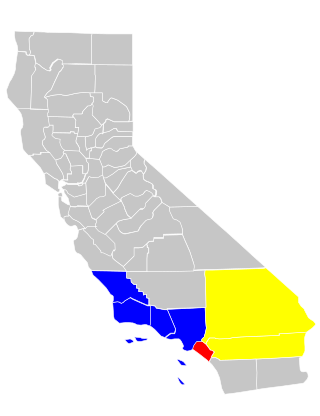Top Qs
Timeline
Chat
Perspective
United States District Court for the Central District of California
U.S. federal district court in California From Wikipedia, the free encyclopedia
Remove ads
The United States District Court for the Central District of California (in case citations, C.D. Cal.; commonly referred to as the CDCA or CACD) is a federal trial court that serves over 19 million people in Southern and Central California, making it the most populous federal judicial district.[1] The district was created on September 18, 1966. Cases from the Central District are appealed to the United States Court of Appeals for the Ninth Circuit (except for patent claims and claims against the United States government under the Tucker Act, which are appealed to the Federal Circuit). Along with the Central District of Illinois, the court is the only district court referred to by the name "Central" – all other courts with similar geographical names instead use the term "Middle".
Remove ads
History
California was admitted to the union on September 9, 1850, and was divided into two federal trial court districts – Northern and Southern – by Act of Congress on September 28, 1850, 9 Stat. 521.[2] The boundary was at the 37th parallel.[3] The two districts were merged as the United States District Court for the District of California on July 27, 1866, by 14 Stat. 300.[2][3] On August 5, 1886, Congress re-created the Southern District by 24 Stat. 308,[3] while the northern half was renamed Northern District. The Eastern and Central Districts of California were created on March 18, 1966 from portions of the Northern and Southern Districts by 80 Stat. 75.[2]
Remove ads
Divisions
The U.S. District Court for the Central District of California is divided into three divisions, with jurisdiction over seven counties: Riverside, San Bernardino, Orange, Los Angeles, San Luis Obispo, Santa Barbara, and Ventura.
The Eastern Division covers Riverside and San Bernardino Counties at the Riverside courthouse.
The Southern Division covers Orange County from the Ronald Reagan Federal Building and Courthouse in Santa Ana.
The Western Division covers Los Angeles, San Luis Obispo, Santa Barbara, and Ventura Counties. Cases are heard in two courthouses in downtown Los Angeles. All but two district judges are located in the new First Street Courthouse, whereas magistrate judges and two district judges maintain chambers in the Edward R. Roybal Courthouse.
Remove ads
United States attorney for the Central District of California
The United States attorney for the Central District of California represents the United States government in civil and criminal cases before the court. Since April 2, 2025, the interim U.S. Attorney for the district is Bill Essayli.
Current judges
Summarize
Perspective
As of June 1, 2025[update]:
Remove ads
Former judges
- Reassigned from the Southern District of California.
Remove ads
Chief judges
Chief judges have administrative responsibilities with respect to their district court. Unlike the Supreme Court, where one justice is specifically nominated to be chief, the office of chief judge rotates among the district court judges. To be chief, a judge must have been in active service on the court for at least one year, be under the age of 65, and have not previously served as chief judge.
A vacancy is filled by the judge highest in seniority among the group of qualified judges. The chief judge serves for a term of seven years, or until age 70, whichever occurs first. The age restrictions are waived if no members of the court would otherwise be qualified for the position.
When the office was created in 1948, the chief judge was the longest-serving judge who had not elected to retire, on what has since 1958 been known as senior status, or declined to serve as chief judge. After August 6, 1959, judges could not become or remain chief after turning 70 years old. The current rules have been in operation since October 1, 1982.
Remove ads
Succession of seats
Summarize
Perspective
Remove ads
List of U.S. attorneys
- George J. Denis (1888–1889)[4]
- Aurelus H. Hutton (1889–1890)
- Matthew T. Allen (1892–1893)
- George J. Denis (1893–1897)
- Frank P. Flint (1897–1901)
- Louis H. Valentine (1901–1905)
- Oscar Lawler (1905–1909)
- Albert Schoonover (1913–1917)
- J. Robert O’Conner (1917–1921)
- Joseph C. Burke (1921–1925)
- Samuel W. McNabb (1925–1933)
- John Rose Laying (1933)
- Peirson M. Hall (1933–1937)
- Ben Harrison (1937–1940)
- William Fleet Palmer (1940–1942)
- Leo V. Silverstein (1942–1943)
- Charles H. Carr (1943–1946)
- James M. Carter (1946–1949)
- Ernest A. Tolin (1949–1951)
- Walter Binns (1951–1953)
- Laughlin Edward Waters Sr. (1953–1961)
- Francis C. Whelan (1961–1964)
- Thomas R. Sheridan (1962–1964)
- Manuel L. Real (1964–1966)[5]
- John K. Van de Kamp (1966–1967)
- William Matthew Byrne Jr. (1967–1970)
- Robert L. Meyer (1970–1972)
- William D. Keller (1972–1977)
- Robert L. Brosio (1977) (Acting)
- Andrea S. Ordin (1977–1981)
- Alexander H. Williams, III (1981) (Acting)
- Stephen S. Trott (1981–1983)
- Alexander H. Williams, III (1983–1984)
- Robert C. Bonner (1984–1989)
- Gary Allen Feess (1989)
- Robert L. Brosio (1989–1990)
- Lourdes Baird (1990–1992)
- Terree Bowers (1992–1994)
- Nora Margaret Manella (1994–1998)
- Alejandro Mayorkas (1998–2001)
- John S. Gordon (2001–2002)
- Debra Wong Yang (2002–2006)
- George S. Cardona (2006–2007)
- Thomas P. O'Brien (2007–2009)
- George S. Cardona (2009–2010) (Acting)
- André Birotte Jr. (2010–2014)
- Stephanie Yonekura (2014–2015) (Acting)
- Eileen M. Decker (2015–2017)
- Sandra R. Brown (2017–2018) (Acting)
- Nicola T. Hanna (2018–2021)
- Tracy L. Wilkison (2021–2022) (Acting)
- E. Martin Estrada (2022–2025)
- Joseph T. McNally (2025) (Acting)
- Bill Essayli (2025–present) (Interim)
Remove ads
See also
References
External links
Wikiwand - on
Seamless Wikipedia browsing. On steroids.
Remove ads

